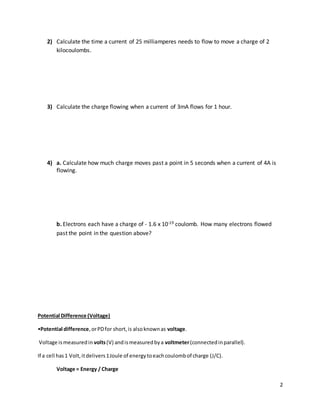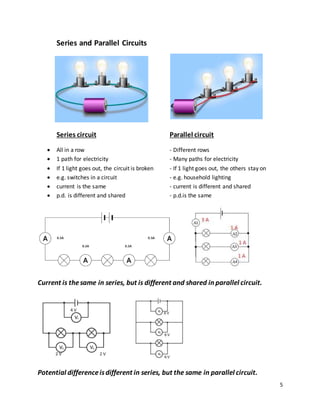current and voltage in series and parallel- worksheet
- 1. 1 ICS, Abu Dhabi Physics notes, worksheet Name: Gr: 10 G, H Current and potential difference Current: The flow of charge per second. The SI unit is the Ampere (A). An ammeter measures the current in a circuit. It is connected in series. Charge (Q) = current (A) x time (s) Q = I x t I = Q / t The conventional current direction is the direction the positive particles would travel in. This is the opposite of what actually happens, as it is the negative particles (electrons) that move. Conventional current goes from the positive side to the negative side. Electron flow goes from the negative side to the positive side. Solve the following: 1) Calculate the current flowing if a charge of 60 coulombs flows in 1 minute.
- 2. 2 2) Calculate the time a current of 25 milliamperes needs to flow to move a charge of 2 kilocoulombs. 3) Calculate the charge flowing when a current of 3mA flows for 1 hour. 4) a. Calculate how much charge moves past a point in 5 seconds when a current of 4A is flowing. b. Electrons each have a charge of - 1.6 x 10-19 coulomb. How many electrons flowed past the point in the question above? Potential Difference (Voltage) •Potential difference, or PD for short, is also known as voltage. Voltage is measured in volts (V) and is measured by a voltmeter (connected in parallel). If a cell has 1 Volt, it delivers 1 Joule of energy to each coulomb of charge (J/C). Voltage = Energy / Charge
- 3. 3 Volts = Joules / Coulomb V = E / Q Electro-motive force  The emf of a cell is the work done per unit charge by the cell in moving the charge round a complete circuit. •The maximum voltage a cell can produce is called the electromotive force (EMF), measured in volts.  When a current is being supplied, the voltage is lower because of the energy wastage inside the cell. A cell produces its maximum PD when not in a circuit and not supplying current. Potential difference The p.d. across a component is the work done per uni t charge in moving the charge through the component. (The potential difference across a component in a simple circuit is less than the emf of the cell. But for simplicity, we assume them to be the same for calculations.) Solve the following: 1) What is the potential energy lost by a charge of 0.2 C passing through a bulb of potential difference 4V? 2) If 3 J of potential energy is spent by a charge of 0.4 C across a resistor, calculate the p.d. of the resistor?
- 4. 4 3) Copy out and complete the table below. You may need to use the equations Q = I t and R = V / I voltage charge energy current time resistance 6C 18J 2s 5C 40J 5A 12V 24J 3Ω 100V 4C 8s 6A 10s 10Ω Circuit diagram Circuit Symbols
- 5. 5 Series and Parallel Circuits Series circuit Parallel circuit ď‚· All in a row - Different rows ď‚· 1 path for electricity - Many paths for electricity ď‚· If 1 light goes out, the circuit is broken - If 1 light goes out, the others stay on ď‚· e.g. switches in a circuit - e.g. household lighting ď‚· current is the same - current is different and shared ď‚· p.d. is different and shared - p.d.is the same Current is the same in series, but is different and shared in parallel circuit. Potential difference is different in series, but the same in parallel circuit.
- 6. 6 Solve the following: 1. 2. 3.






